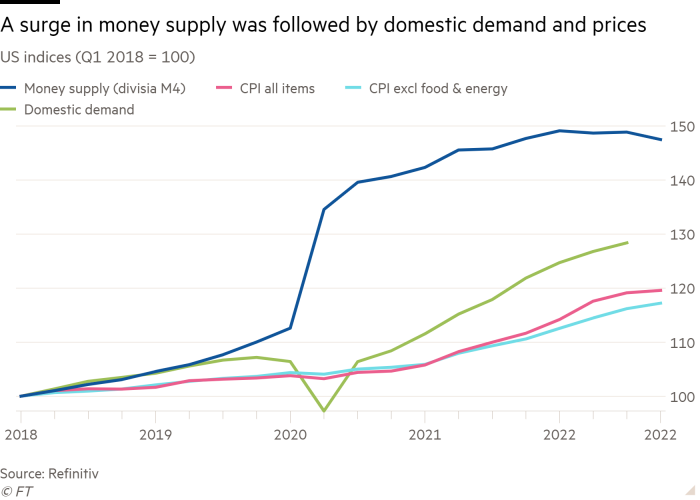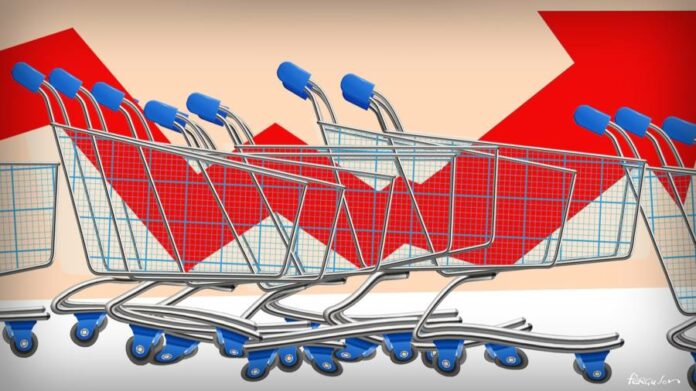What can we learn from monetarists about what happened to prices after the Covid-19 pandemic struck? What can we learn from the mistakes made in the 1970s? The purpose of posing these questions is to inject humility into current debates, especially among central bankers. Their failure to forecast, or prevent, the big jumps in price levels of recent years is significant. So, why did it happen and what might history suggest about the mistakes still to come?
It is possible to argue that there is nothing to learn. Covid-19 was, it might be suggested, a unique event to which policymakers responded in the most sensible possible way. Similarly, the 1970s are ancient history. Our policymakers would not make the mistake of letting inflation shoot up again, so embedding expectations of permanently high inflation. I would like to believe these propositions. But I do not.
Start with money. There have been two obstacles to taking the money supply seriously. The more important is that it was discarded as a target and even an indicator by “respectable” macroeconomists long ago. The less important was the hysteria of so many about the quantitative easing introduced after the global financial crisis. This obscured what was so very different this time.
As I noted in a column published almost a year ago, the British economist Charles Goodhart argued back in 1975 that “any observed statistical regularity will tend to collapse once pressure is placed upon it for control purposes”. That insight proved relevant to the monetarism of the 1980s. But, I suggested, there is a corollary: if it is no longer used as a target, money might become a useful indicator once more.

Recently, Claudio Borio of the Bank for International Settlements has suggested how this might become the case for money, once again. Thus, he argues, whether money matters depends on whether inflation is high, or not. In other words, the presence of “excess money” on balance sheets influences behaviour more when people are sensitive to inflation than when they are not.
In an excellent recent post on Money: Inside and Out, Chris Marsh of Exante Data explains how money fell out of the thinking of monetary economists and central bankers. He notes however that a large expansion of the supply of money is likely to affect spending significantly. That is even more likely if the money created by central banks effectively funds fiscal deficits, as happened so strikingly in 2020.

A crucial point is that this differed greatly from what happened after 2008. The result of the financial crisis was a dramatic slowdown in the creation of money by bank lending. The money created by the central banks through their asset purchases (QE) offset this endogenous slowdown in monetary growth. This significantly reduced the severity of the post-crisis economic slowdown.
In early 2020, the opposite was true: private credit growth and money creation by the central banks were both very strong. Average annual growth of US M2 from end 2008 to end 2019 was just 6 per cent. In the year to February 2021, it grew 27 per cent. It is not surprising then that, with the fiscal boosts as well, US nominal domestic demand rose by more than 20 per cent in the two years to the third quarter of 2022. That generated a strong recovery. But it also supported a jump in the price level: in the two years to December 2022, the core US consumer price index rose 11.5 per cent, far above the 4 per cent implied by the Federal Reserve’s 2 per cent annual target.

That was the past. What now? Measures of US broad money are now actually falling. In December 2022, for example, US M2 was 2.5 per cent below its peak in March. Data on broader measures provided by the Center for Financial Stability show the same picture. This suggests that inflation might fall faster than expected. It is even possible that if the aim is only to stabilise inflation rather than make the price level fall back, policy is too tight.
Yet there still seems to be a monetary overhang. In addition, the Danish economist, Jesper Rangvid, in his January 2023 blog, provides a sobering comparison with the 1970s. He notes, rightly, the relevance of comparisons with another period when a combination of strong fiscal and monetary expansions interacted with supply shocks to generate high inflation. But in the 1970s, there were two spikes. Energy prices played a role in both. But so, too, did expansionary monetary policy.

Rangvid adds that: “As soon as inflation started falling in the early 1970s, the Fed reduced the Fed Funds Rate. This was too early. It implied that the real interest rate fell too fast and too much.” In December 2022, what the Federal Reserve Bank of Atlanta calls “sticky price” inflation was running at over 5 per cent on a one-month annualised, three-month annualised and annual basis. Rangvid concluded that it might take even longer to get inflation back down to 2 per cent than it did in the mid-1970s, perhaps another two years. But there is a danger not only of loosening too soon, but also of loosening too far under what is quite likely to be fierce political pressure, so generating another upsurge.
The big point is that the inflation genie is now out of his lamp. I agree with Rangvid that monetary policy should have been tightened sooner. I also agree with Marsh that central banks should not have ignored money, as Mervyn King has also argued. There might be a case for waiting to see what happens before further tightening, at least in the US, especially if one focuses on the monetary data. But inflation might also prove stickier downwards than hoped. Whatever happens, do not repeat what happened in the 1970s: get inflation down and then keep it down.






